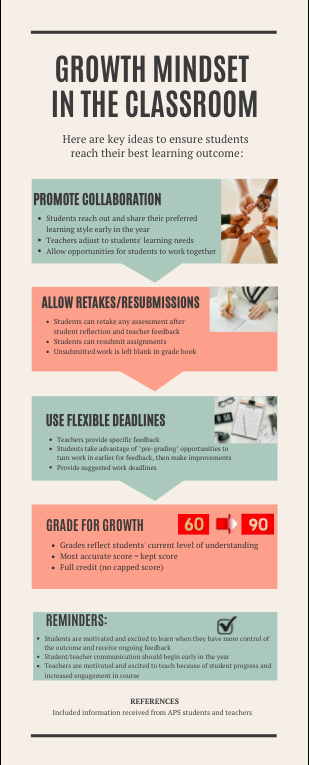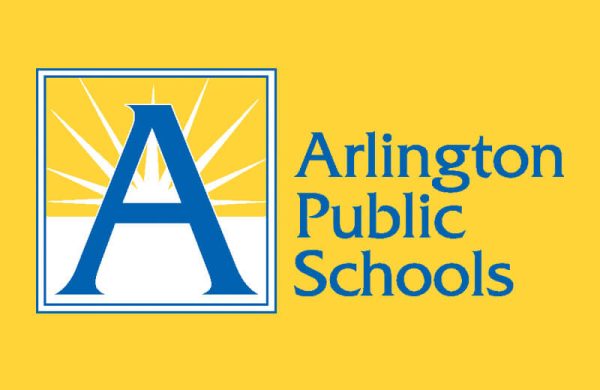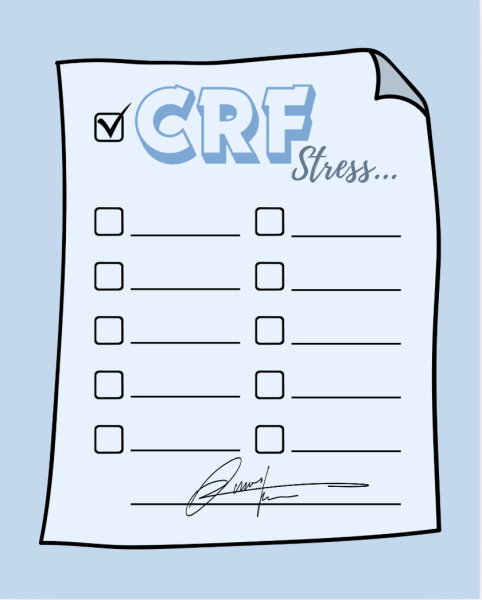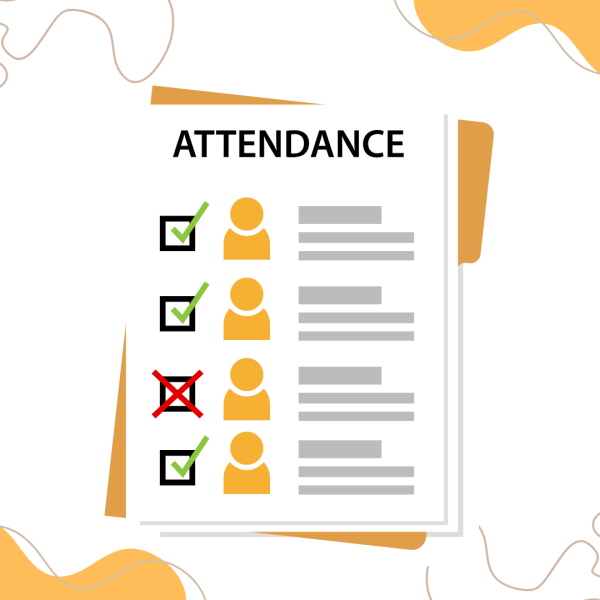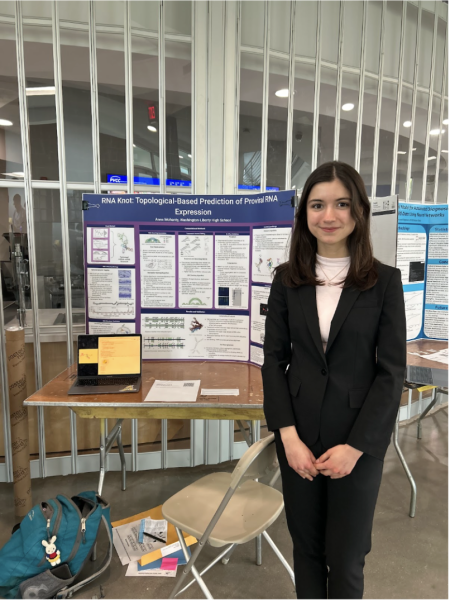Growth-mindset: working toward an improved education system
Looking at our traditional grading system and examining how to improve through the eyes of teachers and students.
Step-by-step guide to using growth mindset practices in classrooms
Traditional school systems use fixed-mindset grading policies. These policies often include practices such as averaging scores, not allowing test retakes, and penalties for late or missing work. While teachers may believe that this system is the only way to properly grade, it is not, and an increasing number of school systems around the county are shifting away. The phrase that captures the philosophy behind the shift is “growth mindset.”
“In a growth mindset, people believe that their most basic abilities can be developed through dedication and hard work—brains and talent are just the starting point,” Carol Dweck, Professor of Psychology at Stanford University, wrote in her book Mindset.
In simple terms, this means that students are allowed to show growth over time, thus being given additional opportunities to more fully learn and then demonstrate their understanding. Dweck spoke at a TedTalk describing the improvement teachers saw from implementing a growth mindset. Dweck mentions that this means whether a student turns in an assignment and gets a perfect score or failing (or “not yet”), they should receive information about their strengths and weaknesses and continue to improve based on this. School systems that focused on growth mindset significantly raised the below-average classes to above-average.
After reading Dweck’s work and starting the practices for himself, a young teenage boy wrote the following words, which were mentioned in the TedTalk, “Dear Professor, I appreciate that your writing is based on solid scientific research, and that’s why I decided to put it into practice. I put more effort into my schoolwork, into my relationship with my family, and into my relationship with kids at school, and I experienced great improvement in all of these areas. I now realize I’ve wasted most of my life.”
A growth-mindset teacher can be critical to ensure satisfaction with a class. They are often recognizable to students by how they make significant efforts to help their students.
“My AP teacher, Mr. Sharp, is definitely a good example of a growth mindset teacher because not only is he the type of teacher who doesn’t take off late points for work, he’s super understanding when it comes to events,” Yabsera Sam, junior at Wakefield High School, said. “When it comes to classes similar to his, I’m building not only a close connection with my teacher, but I’m also building much more fondness [for] learning English.”
“…Just generally trying to not get frustrated when someone isn’t getting something the first time because people learn differently. Sometimes people just need to hear something a few times or switch up the way they’re listening to it or the way they’re getting the information. I think it’s really helpful when people aren’t immediately judging [by saying] ‘you’re doing it wrong or it’s not that difficult’,” Sarah Eichorn, a sophomore at Washington-Liberty said.
While it’s important that teachers have a considerate personality, it’s also helpful when they can adapt to students’ different learning styles to do the best they can in the class.
“Everybody learns in different ways, it’s important to acknowledge that. It can be hard for people to come up with new ways of learning, but especially if you are [a] student you can voice that to a teacher. ‘Is there another way I might be able to learn this that I think can be really helpful?” Sarah Eichorn, a sophomore at the school, said.
The book that our teachers are currently reading as a community is called Grading for Equity. It describes the practices that could potentially help students grow and become more engaged learners and indicates where school systems struggle with the issues in their policies.
W-L teachers are currently reading the book and discussing the ideas on early release days with one another to address how they feel about the practices and how to implement them into each department.
“So far, I’m curious about where it’s going to go. So what I’ve read so far is mostly what his [the author, Joe Feldman,] justification is for why we need to make some changes. Unfortunately, many of the things he says we need to change we already don’t do,” Mr. Jim Zarro, IB Math teacher and Math Department Chair at Washington-Liberty, said. “I’m a little worried that this is a general idea versus a specific thing to what we’re doing and what. W-L and the math department at APS need to change. But they keep saying we should change things when we’re not already doing.”
Some of the messages that this book describes reveal how we do not make education equitable for everyone.
“It’s not an easy thing to adopt a one-size-fits-all kind of way, but that is fundamentally inequitable. If we’re going to deliver public education to all of our young people in our country, we have to make deliberate efforts to make sure that we teach in an equitable way, taking into account advantages and disadvantages, all the way down to the individual level,” Mr. Richard Greene, W-L AP, and sophomore English teacher said.
In APS, a growth mindset is not what is available in all classes, although it can differ based on the teacher and philosophy. The typical grading system is that homework and classwork take up a small percentage, projects are the next highest portion, tests/quizzes have the power to make or break your grade, homework is due by the set deadline with no exceptions, and students cannot resubmit any graded work unless there is a significant exception mentioned earlier in the year. The community has been following this system as the end-all-be-all, but, in reality, there is another way to grade that can be more beneficial to the student and the student body.
One major question for school systems is why averaging is chosen out of the options of mean, median, mode, and range. An example of this is also discussed in Chapter 8 of “Grading for Equity.” Say a student got the following scores on their exams for the quarter: 40, 91, 92, 94, and 94. If one used all the methods to calculate scores, the mean would be 82.2%, the mode is 94%, and the median is 92%. Comparing the numbers, the mean is significantly lower than the other methods, and a way to turn your solid A or A- into a B-. This grading system, the norm according to traditional grading, significantly puts this student at a disadvantage.
The reason school systems average grades is to show how the student has performed throughout the semester as a whole, but not where the students are at the current moment. One major concern that teachers and some students may have in moving to growth mindset is that they will not study until later and instead slack off, but teachers who use growth mindset correctly and have it set up for students to receive feedback and then to go back and look over their work find that the majority of students are conscientious and do better.
“I don’t have deadlines. I will accept student work all the way to the very last day of the marking period. Most students actually will produce work when you tell them to. 80% of students will get it done, and most of my work is project-based and group-based, so it’s easier to get things done because everybody works together. The way I teach the skills required to do well is effective, and I have the evidence to bear that out, and I like it. 70% of my students get a three or better [on AP exams] and that’s well above the global average, so I think we’re doing something right here,’” Mr. Greene said.
Some classes may have strict policies about having your homework with you on the deadline, and, if you do not, no matter the reason, you will receive a zero or a highly-reduced grade.
“I think especially if it’s one of those kinds of once-off sort of things or for whatever reason, you just couldn’t get in on time, teachers need to be a little bit more understanding and aware. Everybody has other stuff going on outside of school and yes, people do try and make school one of their priorities, but sometimes it comes second,” Eichorn said.
Greene has also structured his courses such that the majority of the work happens in the classroom.
“I don’t give homework. I don’t like to see students who are overburdened with intellectual and academic work, when they should be at home, resting, sleeping, being with their family, pursuing extracurricular activities, having a heart, having hobbies, working if they want. Some students may want more time at home to work at their own pace and of course, they always have that option,” Greene said.
While this system may sound wonderful to students and a great way for teachers to ensure more passing students, it can be difficult for teachers to provide feedback. Feedback is when someone completes an action, and the receiver provides comments on the strengths and areas for growth of the work. Traditional grading structures motivate students by saying “nice work” or “great job,” on an assignment, but that may discourage them from looking through the rest of the test to see what they did well and what they still need to work on.
Quality feedback is incredibly important to students and indicates how they need to improve. However, it needs to be clear and direct.
“It’s definitely helpful when teachers give you enough feedback that you can make a valuable improvement to work [on] because sometimes I think there are comments that get made for certain classes and certain pieces of work that you genuinely don’t know what to fix there because you don’t know what’s wrong. I had an assignment that I got feedback on but the feedback wasn’t telling me what I did wrong. I felt really conflicted about how to fix it because I wasn’t sure what was wrong with it because I thought it was okay,” Eichorn said.
Feedback is important to students for all classes, but math can also be something that should be more focused on.
“There’s always a multitude of different processes to get to that answer [in math],” “Teachers should be giving their feedback and should be [saying] ‘…with this, I understand that they usually like to do it in this method, and they have this type of thinking process,’” Sam said.
Teachers can demonstrate the importance of reviewing feedback in the exams as it may appear on a later assessment.
“I think that it is important to look at [testing marks]. In fact, I’m about to give a midterm in one of my IB classes, where it’s ‘let’s go back and look at your old tests and not only look at what did you get wrong but look at the stuff you got right, do you still remember it?’” Mr. Zarro, W-L IB Math SL teacher, and Math Department Chair said.
The growth-mindset process may be time consuming and not easily achievable due to the fast pace of our current school environment, though in reality it would be a much better help to students. The “perfect world” that teachers describe with feedback and time to reflect on your work is not currently possible with the number of students, which shows a definite flaw in how the school system can negatively impact students and learning. It is true that in some classes there may be a student who initially does not appear to express as much care and concern as they should. However, it is logically correct that a student who did not earn a satisfactory grade on an assignment would pay attention to teaching comments, particularly if the teacher intends on keeping a positive relationship with the student, no matter the grade.
Starting in around the fifth or sixth grade, in order to give advanced students more of an opportunity to be challenged and for students to feel more comfortable in their classes, APS started separating students based on demonstrated aptitude. Math, in particular, is a subject where students may feel rushed to be at the highest level, which can cause definite concern for students who may not have the full understanding of mathematical concepts.
“It’s a tough thing to do. You don’t want students to sit in a class where they’re bored and they don’t learn anything. But I do think there has been some reduction of the push for 7th-grade Algebra I, I think there were students who were put into it, who maybe could do the math and get the right answer but not understand the concepts, they just weren’t ready for it,” Zarro said.
The speed of math class and competition to be at the highest level also adds challenges to students and teachers.
“I think there’s a lot of ‘playing school where students can kind of mimic what the teacher did, but when they have to do something on their own and extend it, it doesn’t happen,” ___ said.
In particular, if students rush their learning, this might impact their success later when they just tried to get the points on the work and then do not fully understand the ideas.
“I think there needs to be a balance between ‘Yes, you need to know your multiplication facts are important, good to know, but the bigger picture of what does three times seven mean’. When you’re factoring something, ‘why are we factoring something, what does that mean’. Part of it, I think, unfortunately, the math curriculum is too much content every year, so we have to go through things so fast. There’s not time for students, especially in advanced courses. It just goes fast because we’re expected to do so much that there’s not time to really develop those concepts,” Zarro said.
One course of action that some APS teachers have taken is to average multiple tries on a test. However, if a student were to receive a 60% on a test and then a 100% the next try, their average score would be a B- (80%), which does not reflect their now full understanding of the material and discourages efforts to fully learn. The traditional practice in many APS classes to use averaging requires students to understand the material the first time and then move on to the next unit. Giving extra opportunities does not necessarily mean that the class simply becomes “easier,” it just means that students are able to understand the class material more. For teachers that currently use a growth mindset system, particularly retakes, students need to take time to review the material and the questions they missed, which means students would be encouraged to do their best on the first try to have less of a review on the second.
Some teachers require a certain score in order to retake and/or a maximum score that can be received, which is harmful to student learning.
“When it comes to teachers, post-test, usually, as long as you get above a B or above a B plus, you can’t retake, that’s just a good enough score. But for some students, it’s not a good enough score, and they really want to know how to improve and work on certain things,” Sam said.
While testing retakes are beneficial to students who would like to raise their grades, it is important to preserve students’ mental health and also focus on their strengths, not just areas for growth.
“I think that should be up to the student. Honestly, I’ve had an issue with perfectionist culture, in my experience. As a student, I have issues sometimes where I will push myself too far. I’ve had to learn to be really happy sometimes with grades that aren’t that perfect 100. I’m not saying, ‘Oh, I really struggled to be happy with a 97’. But, in all honesty, I think many kids have had times where they’re like, ‘okay, 90, well, I kind of wish I had done better on this, or an 85 or even 80’ but I started being more okay and accepting and gentle with myself as I received those scores. So I would say that while it’s important to realize how you can improve, I also don’t think that should come at the cost of your mental health and you should constantly be striving for that 100% at the expense of other things, like sometimes you just need to be proud of yourself for the work that you’ve done,” Savvy Thompson, IB senior at the school, said.
In order to prepare for the next assessment, students need to review and spend time with their teacher. The provided time during Generals Period may not be enough to go around and visit your teachers.
“I really wish there was a bit more time even if it was on Wednesdays for an hour we would have time to go to teachers and try to ask questions and get more information because I know I’ve gone to GP for math classes before and it’s been stressful because you really have 30 minutes to try and get through sometimes a number of questions. It can be stressful to learn it, turn it in, and understand it and don’t have more time than half an hour,” Eichorn said.
One of the reasons school systems claim that high school is difficult is so it can prepare students for college, both with the rigor of the courses and the format of classes; however, the process to do so is not always beneficial. Teachers mention many times that the difficult course load is meant to prepare us for higher education, without realizing that college students are allowed opportunities to provide feedback on whether or not teachers are effective.
“College students are allowed to bring attention to how this professor is doing. You always hear ‘high school can be hard, or teachers aren’t going to be as forgiving.’ Getting us ready for higher education experience would be giving us the opportunity to put our teachers in a position where they are in check of their learning and teaching styles,” Sam added.
Partial credit is a growth-mindset practice that can be a good way to honor what students did correctly and indicate where they went wrong and therefore, not have an entire answer marked wrong for containing a simple, careless mistake like 3 + 5 = 7 within a problem where the student is following the process correctly.
“My teacher this year has been really good with partial credit. Each question is worth four points except you can get everything right until the very last step, and mess up on the very last step. You can get three points for the question and I find that really helpful,” Eichorn said.
Retakes can be helpful for students, but sometimes it can be stressful for teachers to come up with a format.
“When there is a retake, it can be in different forms, it might not be taking the exact same test again. Looking back on the questions that you missed, going back over them and explaining them and redoing them and handing that in instead, that’s kind of better personally than doing an actual retake of the whole test. I think that’s a really good idea,” Eichorn said.
Extra-credit problems can be a soothing way for students to not stress or possibly not need a retake.
“I think extra credit is really helpful, especially on tests and their questions. This year in math, we have some fun, random questions that you can get an extra point or two on, and that helps you take a second and know, it’s gonna be okay. You can’t get points off if you fail the extra credit, or sometimes they’re a little bit harder, but something that we’ve learned in that unit,” Eichorn said.
To improve the quality of education, some teachers have students fill out a survey regarding how well the students learned, which makes the teacher accountable for their teaching abilities. While Grading For Equity is under discussion among faculty, currently students are in classes where the teaching philosophy on grading can be different from one class period to the next.
“It would be helpful if there was a survey that showed what they thought their strong points in terms of a teaching style were. ‘How, on a scale of one to five, do you think this person is a good hands-on teacher’, and then you can see those ratings. I think that would be more helpful to me personally,” Eichorn said.
A reflective survey system could either be placed during the semesters or at the end of the school year.
“A survey system like this would [be] most useful if it was given at the end of 1st or 3rd quarters, rather than at the end of an academic year,” Greene said.
The first step to improving education is working to ensure that students and teachers are both doing well.
“We all ask about how the students are doing and how the curriculum is affecting the students, but I’ve seen it’s taking a toll on our teachers, and especially the quality of education they’re able to provide in the classroom,” Sam said.
Working toward ensuring success through policy implementation will ensure the best learning environment.


